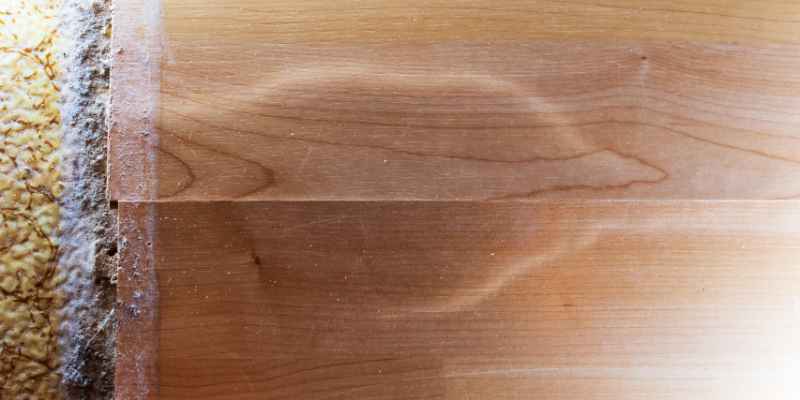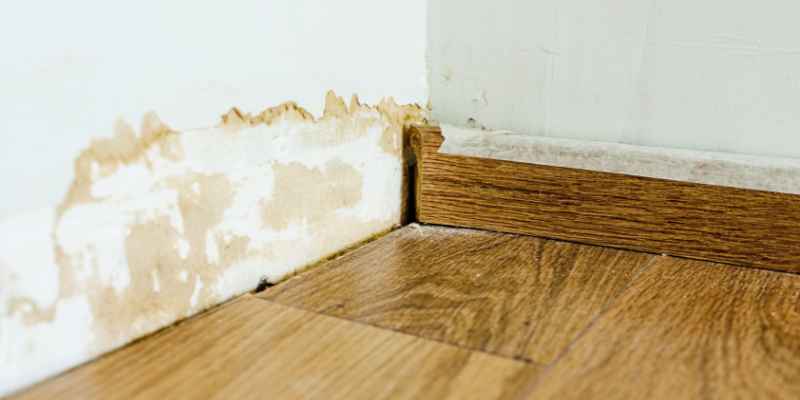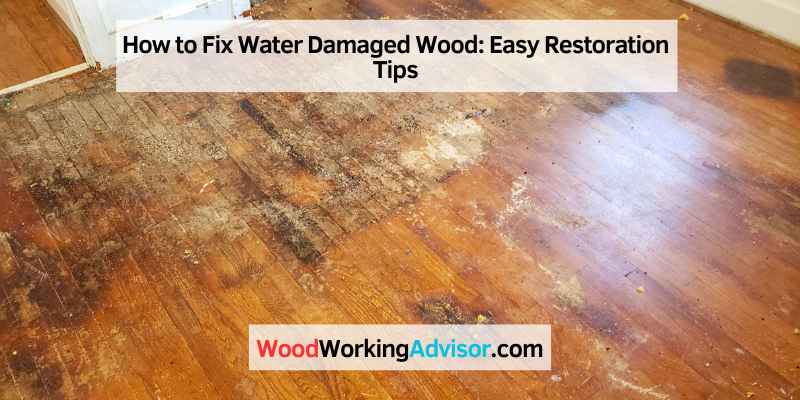To fix water-damaged wood, start by drying the wood thoroughly and then sanding and refinishing it. Additionally, you can use wood hardener to strengthen the damaged areas.
It’s important to address water damage promptly to prevent further deterioration of the wood. Whether the damage is on furniture, floors, or other wooden surfaces, these methods can help restore the wood to its former condition. Understanding the extent of the damage and taking appropriate steps can make a significant difference in salvaging water-damaged wood.
In this blog, we’ll explore effective techniques for repairing water-damaged wood and restoring it to its original state.
Identifying Water Damage
Identifying water damage is the crucial first step in fixing water-damaged wood. Recognizing the signs of water damage and assessing the extent of the damage will help in determining the most effective course of action.
Signs Of Water Damage
1. Discoloration: Look for dark spots or stains on the wood, which indicate prolonged exposure to moisture.
2. Warped or Buckled: Check for any warping, buckling, or sagging in the wood, as this is a common sign of water damage.
3. Mold and Mildew: Presence of mold or mildew on the wood surface is a clear indication of water damage.
4. Musty Odor: A musty or damp smell emanating from the wood is often a sign of water damage.
Assessing The Extent
1. Probe the Wood: Use a screwdriver to gently probe the wood for soft spots, which indicate severe water damage.
2. Check Surrounding Areas: Examine the surrounding areas for signs of water damage, as the source may not always be directly visible.
3. Measure Moisture Levels: Utilize a moisture meter to measure the moisture content within the wood, providing insight into the extent of the damage.
Preparation For Restoration
To fix water-damaged wood, start by drying the affected area thoroughly with fans and dehumidifiers. Next, use sandpaper to smooth the surface, and apply wood filler to any cracks or holes. Finish by sanding and refinishing the wood to restore its original look and strength.
Before restoring water-damaged wood, preparation is necessary to ensure safety and efficiency. Gathering necessary tools and taking safety measures are important steps to take before starting the restoration process.
Gathering Necessary Tools
To restore water-damaged wood, the following tools are necessary:
- Protective gear (gloves, goggles, and a face mask)
- Dry towels or rags
- A vacuum cleaner with a hose attachment
- Sandpaper
- A wood cleaner solution
- Wood filler
- A paintbrush or roller
- Stain or paint
Safety Measures
Restoration of water-damaged wood can be hazardous, especially if the damage is extensive. Taking safety measures is crucial to prevent injuries. Here are some important safety measures to follow:
- Wear protective gear to prevent exposure to mold, bacteria, and harmful chemicals.
- Ensure that the area is well-ventilated to prevent the accumulation of harmful fumes.
- Turn off the power supply in the affected area to prevent electrical hazards.
- Use caution when handling power tools to avoid injuries.
- Dispose of contaminated materials properly to prevent the spread of contamination.
In conclusion, preparation is crucial when restoring water-damaged wood. Gathering necessary tools and taking safety measures are important steps to take before starting the restoration process. By following these steps, you can ensure safety and efficiency while restoring your water-damaged wood.
Drying Out Water Damaged Wood
Fixing water damaged wood is crucial to prevent further deterioration. Follow these steps to dry out water damaged wood: remove excess water, use fans or dehumidifiers, apply a wood preservative, and monitor for mold growth. Swift action can salvage your wood and restore its integrity.
Natural drying methods are cost-effective and eco-friendly.
Natural Vs. Artificial Drying Methods
Natural drying methods involve air circulation and sunlight.
Artificial drying methods include using fans and dehumidifiers.
Preventing Further Damage
Place wood in a well-ventilated area to dry out.
Use a moisture meter to check wood dryness progress.
Cleaning The Affected Area
To fix water damaged wood, start by cleaning the affected area. Use a mixture of warm water and mild detergent to gently scrub the surface, then dry it thoroughly with a clean cloth. Avoid using harsh chemicals or abrasive materials that could further damage the wood.
Cleaning the affected area is the crucial first step in fixing water-damaged wood. The process involves removing any standing water and moisture from the surface before proceeding to the actual cleaning. Here are the essential steps to follow when cleaning a water-damaged wood surface:
Choosing The Right Cleaning Solutions
Before you start cleaning the affected area, you need to choose the right cleaning solution for the job. The type of cleaning solution you choose will depend on the type of wood and the extent of the damage. Mild soap and water are usually enough for light water damage, while heavy damage may require stronger solutions like bleach or vinegar. Always wear protective gloves and a mask when using harsh chemicals.
Mold And Mildew Removal
Mold and mildew are common problems that arise from water damage. These fungi can cause health problems and further damage to the wood if left untreated. To remove mold and mildew from the affected area, mix equal parts of bleach and water in a spray bottle and apply it to the affected area. Let the solution sit for 15 minutes before scrubbing the area with a brush. Rinse the area thoroughly with water and dry it with a clean cloth.
In conclusion, cleaning the affected area is the first and most crucial step in fixing water-damaged wood. Choose the right cleaning solution for the job and remove any mold or mildew using a mixture of bleach and water. By following these steps, you can restore your water-damaged wood to its former glory.
Sanding And Scraping
To fix water-damaged wood, start by sanding and scraping the affected areas to remove damaged layers. This process helps restore the wood’s surface and prepares it for further repairs or refinishing. Sanding and scraping are essential steps in repairing water-damaged wood effectively.
Techniques For Effective Sanding
Sanding is an essential step in fixing water-damaged wood as it helps to restore its smoothness and remove any rough or damaged areas. Here are some effective techniques to consider:
- Start with coarse grit sandpaper: Begin the sanding process by using coarse grit sandpaper, such as 60 or 80 grit. This will help to quickly remove any damaged or raised wood fibers.
- Work in the direction of the grain: Always sand in the same direction as the wood grain to prevent any scratches or marks that may be difficult to remove.
- Apply even pressure: Apply consistent and even pressure while sanding to ensure a smooth and uniform surface.
- Gradually switch to finer grits: As you progress, switch to finer grit sandpaper, such as 120 or 180 grit, to achieve a smoother finish. This will help to eliminate any visible sanding marks left by the coarse grit sandpaper.
- Use a sanding block: To maintain control and avoid uneven sanding, wrap sandpaper around a sanding block or use a sanding sponge. This will help to distribute pressure evenly across the surface.
When To Scrape Vs. Sand
Knowing when to scrape or sand can make a significant difference in the outcome of your wood restoration project. Here’s a guide to help you determine the right approach:
| Scraping | Sanding |
|---|---|
|
|
By understanding the techniques for effective sanding and when to use scraping versus sanding, you can confidently address water damage on your wooden surfaces. Remember to take your time, work patiently, and prioritize the preservation of the wood’s integrity throughout the restoration process.
Applying Wood Filler

When it comes to repairing water-damaged wood, applying wood filler is a crucial step in the restoration process. Wood filler helps to fill in gaps, cracks, and holes, restoring the wood’s structural integrity and providing a smooth, even surface for finishing.
Selecting The Right Wood Filler
Choose a wood filler that matches the color and type of the wood you are repairing. Ensure it is suitable for both interior and exterior use, depending on the location of the damaged wood. Opt for a water-based wood filler for easier cleanup.
Application Tips
- Prepare the damaged area by removing any loose debris and cleaning the surface.
- Using a putty knife, apply the wood filler to the damaged area, pressing firmly to ensure it fills the space completely.
- Smooth the surface of the wood filler with the putty knife, ensuring it is level with the surrounding wood.
- Allow the wood filler to dry completely before sanding the area to achieve a seamless finish.
Finishing Touches
When it comes to water damaged wood, the finishing touches are crucial in restoring its appearance and durability.
Staining To Match
Staining the wood to match its original color is essential for a seamless repair.
Sealing For Protection
Sealing the wood with a protective finish helps prevent future water damage.
Preventive Measures
To fix water damaged wood, preventive measures are essential. Firstly, remove any standing water and dry the wood completely. Secondly, sand the surface and apply wood filler, followed by sanding again and staining or painting the wood. Finally, ensure proper ventilation to prevent future damage.
Regular maintenance is key to preventing water damage on wood surfaces.
Regular Maintenance Tips
1. Inspect wood surfaces for any signs of water damage regularly.
2. Repair cracks and seal any openings to prevent water infiltration.
3. Keep wood surfaces clean and free from debris to avoid moisture buildup.
4. Ensure proper ventilation in areas with wooden structures.
5. Avoid placing water-prone items directly on wood surfaces.
Waterproofing Solutions
1. Apply a waterproof sealant to protect wood from moisture.
2. Use water-resistant coatings on outdoor wood furniture.
3. Consider using pressure-treated wood for outdoor structures.
4. Install gutters and downspouts to direct water away from wood surfaces.
5. Regularly reapply waterproof coatings for long-lasting protection.

Frequently Asked Questions
How Do You Fix Water Damaged Wood?
To fix water-damaged wood, start by removing any wet or rotten sections. Allow the wood to dry completely before applying a wood hardener or epoxy. Sand the surface smooth and then apply a wood sealer or stain to restore its appearance.
Regular maintenance can prevent future water damage.
Can Water Damaged Wood Be Repaired?
Yes, water-damaged wood can be repaired. The extent of the damage will determine the repair method. Small areas of damage can be patched or filled, while larger areas may require replacement. It’s important to address the issue promptly to prevent further damage and mold growth.
What Causes Wood To Become Water Damaged?
Wood can become water damaged due to various reasons such as leaks, floods, high humidity, or improper sealing. Exposure to moisture for extended periods weakens the wood fibers, leading to warping, rotting, or swelling. Regular maintenance and proper protection can help prevent water damage to wood.
How Long Does It Take For Water-damaged Wood To Dry?
The drying time for water-damaged wood depends on several factors, including the type of wood, extent of damage, and environmental conditions. In general, it can take anywhere from a few days to several weeks for wood to dry completely. Proper ventilation and dehumidification can speed up the drying process.
Conclusion
Fixing water-damaged wood is crucial for preserving its integrity. By following the right steps, you can restore your wood to its former glory. Remember to act quickly, assess the damage, and use appropriate techniques for the best results. Protect your wooden surfaces for long-lasting durability and aesthetic appeal.


